The EA-18G Growler is an airborne electronic attack (AEA) aircraft which operates from either an aircraft carrier or from land-bases. The Growler has been developed as a replacement for the United States Navy EA-6B Prowler aircraft which entered service in 1971 and is approaching the end of operational life.
The Growler is a derivative of the combat-proven two-seat F/A-18 Hornet, the US Navy’s maritime strike aircraft. The aircraft missions are mainly electronic attack (EA) and suppression of enemy air defences (SEAD), particularly at the start and on-going early stages of hostilities.

The Growler aircraft has 11 weapon stations for carrying electronic mission systems and weapons and can then be used to carry out conventional strike missions when the requirements for EA and SEAD sorties are reduced.
EA-18G Growler programme and development
The US Navy awarded a five-year system development and demonstration (SDD) contract in December 2003. A contract for the first four production aircraft was signed in July 2006.
The Growler aircraft’s first test flight was successfully completed in August 2006. This was followed by delivery of the first two test aircraft to the USN in September and November 2006. The first production aircraft was delivered to the USN in September 2007.
The first operational aircraft was delivered to NAS Whidbey Island in June 2008 and operational evaluation began in October 2008 onboard the USS John C Stennis (CVN 74) aircraft carrier. The SDD programme will conclude with an initial operational capability in late 2009 when the first of ten electronic attack squadrons (VAQ) will begin EA-18G operations. Deliveries of 88 Growler aircraft are planned to conclude in 2013. In service the aircraft will carry out a range of missions including stand-off and escort jamming, surveillance and strike.
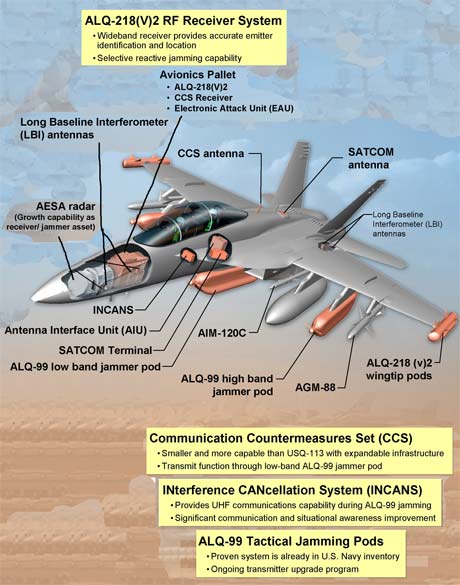
Naval Air Systems Command PMA-265 is the US Navy acquisition office for the EA-18G. The Boeing Company is the prime contractor and weapon system integrator and Boeing also leads the EA-18G Growler industry team. Northrop Grumman is the principal subcontractor and airborne electronic attack subsystem integrator.
The EA-18G Growler fleet will be based at Naval Air Station Whidbey Island, Washington.
AN / APX-111 IFF

The AN / APX-111 is a system for friend-to-enemy detection (IFF), which is used on the F / A-18 Hornet . Produced by BAE Systems .
Description

Technical specifications
- Weight: 20,60 kg
- Volume: 0,0134 m³
- Power consumption: 180 watts
- MTBF : 2500 hours
- MTTR : 15 minutes
- Error detection probability: 97%
Transponder system
- Transmission power: 0.5 kW
- Reception: -76 dBm
- IFF modes: 1, 2, 3 / A, C, 4, S (Mode 5 can be retrofitted)
Query system
- Range:> 185 km
- Transmission power: 1.4 kW
- Reception: -83 dBm
- Target sector: 70 ° × 60 ° (forward direction)
- Angular deviation: ± 2 °
- Distance resolution: <152 m
- Maximum targets: 32
- IFF modes: 1, 2, 3 / A, C, 4 (Mode 5 can be retrofitted)
- Waveform: monopulse
Source wikiwand.com
EA-18G Growler to get artificial intelligence to improve its electronic warfare capabilities
Growler cockpit

The two-seat cockpit has the pilot crew station and the electronic warfare officer’s advanced crew station. The advanced crew station is equipped with a touch-screen liquid crystal display (LCD) mission systems control and display, a 203mm x 23mm (8in x 10in) full-colour tactical LCD, and two multipurpose 127mm x 127mm (5in²) LCDs. The displays have tactical aircraft moving map capability (TAMMAC).
 Pilot
Pilot

Electronic warfare officer’s advanced crew station
Honeywell AMPD 5-by-5-inch display

The AMPD rugged display family consists of 5-by-5-inch forward avionics displays; 5-by-5-inch aft displays, and 8-by-10-inch avionics displays.
The AMPD replaces obsolete cathode ray tube (CRT)-based displays in legacy aircraft, and uses state-of-the-art active matrix liquid crystal display (AMLCD) technology.
The displays are full color, high density, and can be used during the day, at night, and with the night vision imaging system (NVIS). Of the AMPD family, the 5-by-5-inch versions are for the F/A-18E/F/G models, and the 8-by-10-inch versions are for the F/A-18F/G aft cockpit. The 8-by-10-inch model includes a direct digital video input.
The displays provide symbology, raster, and hybrid display formats, and support mono and full-color modes. Source militaryaerospace.com
The aircraft is equipped with HOTAS hands-on throttle and stick control and full digital fly-by-wire controls.
 The aircraft is fitted with a helmet-mounted cueing system developed by the Rockwell Collins and Elbit joint venture company, Vision Systems International.
The aircraft is fitted with a helmet-mounted cueing system developed by the Rockwell Collins and Elbit joint venture company, Vision Systems International.
The HMCS provides ‘first look, first shot’ high off-boresight weapons engagement capability.
The system enables the pilot to accurately direct or cue the weapons against enemy aircraft while performing high-g manoeuvres. The pilot points his head at the target and weapons are directed to the target. Aircraft and mission data such as targeting cues and aircraft performance parameters are displayed directly on the pilot’s visor.

U.S. Navy integrate tablet on EA-18 Growler: Here

The U.S. Navy’s recent demonstration with Boeing integrated a Windows-based tablet into the mission system for the EA-18 electronic attack aircraft for the first time. Photo courtesy of Boeing
Excerpt
The U.S. Navy and Boeing integrated a Windows-based tablet with a EA-18G Growler’s mission system in a recent demonstration of new targeting technologies.
The tablet was integrated with the electronic attack aircraft’s mission system along with an advanced targeting processor, high-bandwidth data link, and an open architecture. Following the integration, the aircraft showed an an enhanced ability to detect targets from long distances, and rapid information sharing capability.
Martin Baker SJU-5/6 zero/zero ejection seat
F-18 Hornet Ejection: Here
EA-18G electronic warfare
The EA-18G integrates advanced airborne electronic attack capabilities, developed and manufactured by Northrop Grumman, with the advanced strike capabilities, including advanced weapons, sensors and communications systems, installed on the F/A-18 Super Hornet aircraft.

The block 1 Growler is fitted with up to three AN/ALQ-99 radar jamming pods, together with an AN/ALQ-218(V)2 receiver and a Raytheon AN/ALQ-227 communications countermeasures system both of which are mounted in the bay previously designated as the F/A-18 Hornet aircraft’s gun bay.
Three AN/ALQ-99 radar jamming pods

3 AN/ALQ-99 jammer
The AN/ALQ-99 jammer fitted on the block 1 Growler is supplied by the EDO Corporation. The AN/ALQ-99 receivers are installed in the tail of the aircraft and the AN/ALQ-99 pod houses the exciters and the high radiated power jamming transmitters.
Raytheon next generation jammer (NGJ)

The Next Generation Jammer gives operators the ability to load a broader variety and higher capacity of electronic attacks, says Jeff Anderson, technical lead for Jammer Technique Optimization (JATO). “It used to take up to 90 days for a contractor to manufacture the design of one of these application specific integrated circuits (ASIC) chips,” Anderson says. “Now we can program our jammer to go against it within hours.”
The JATO group at Point Mugu and at the Naval Research Lab, and the Johns Hopkins Applied Physics Lab specialize in jamming technology along with other electronic warfare methods.
Next Generation Jammer design expanded at Naval Air Warfare Center Military Embedded Systems
Boeing to Provide AN/ALQ-249 Next Generation Jammer (NGJ) for EA-18G in $308M Deal: Here

Excerpt
Boeing will provide Next Generation Jammer (NGJ) integration services for the US Navy’s EA-18G aircraft in a deal worth $308 million. Work ordered in the contract includes the program’s engineering phase, as well as the design and manufacturing tasks for 12 ECP 6472 kits, NGJ pod testing, and additional supporting equipment. The NGJ is a Raytheon-led effort to improve airborne electronic warfare capabilities while replacing the existing AN/ALQ-99 pods used by EA-18G Growler aircraft. Industry partners are aiming to reach initial operating capability for the new pods in 2021.
Electronic warfare: Navy advances next-generation jammer
The Navy’s Next-Generation Jammer, to be ready by 2021, is designed to jam multiple radars at the same time and defeat future high-tech enemy air defenses.
- BY KRIS OSBORN
- OCT 10, 2016
The Navy is engineering a new, more powerful, high-tech electronic warfare jamming technology designed to allow strike aircraft to destroy enemy targets without being detected by modern surface-to-air missile defenses.
“The whole idea is to get the enemy air defense systems from seeing the strike package. It does not matter what type of aircraft we are protecting. Our mission is to suppress enemy air defenses and allow the mission to continue. This is not just designed to allow the aircraft to survive but also allow it to continue the mission – deliver ordnance and return home,” Cmdr. Ernest Winston, Electronic Attack Requirements Officer, said in an interview.
The Next-Generation Jammer consists of two 15-foot long PODs beneath the EA-18G Growler aircraft designed to emit radar-jamming electronic signals; one jammer goes on each side of the aircraft. Radar technology sends an electromagnetic ping forward, bouncing it off objects before analyzing the return signal to determine a target’s location, size, shape and speed…etc. However, if the electromagnetic signal is interfered with, thwarted or “jammed” in some way, the system is then unable to detect the objects, or target, in the same way.
“It is able to jam multiple frequencies at the same time — more quickly and more efficiently,” he said.
The emerging system uses a high-powered radar technology called Active Electronic Scanned Array, or AESA.
“It will be the only AESA-based carrier offensive electronic attack jamming pod it DoD. What it is really going to bring to the fleet is increased power, increased flexibility and more capacity to jam more radars at one time,” Winston added.
The NGJ, slated to be operational by 2021, is intended to replace the existing ALQ 99 electronic warfare jammer currently on Navy Growler aircraft.
The new jammer is designed to interfere with ground-and-air based threats such as enemy fighter jets trying to get a missile “lock” on a target.
One of the drawbacks to ALQ 99 is that it was initially designed 40-years ago and is challenged to keep up with modern threats and digital threats with phased array radars, increased power, increased processing and more advanced wave forms, Winston explained.
The Next-Generation Jammer is being engineered with what’s called “open architecture,” meaning it is built with open computing software and hardware standards such that it can quickly integrate new technologies as threats emerge.
For example, threat libraries or data-bases incorporated into a radar warning receiver can inform pilots of specific threats such as enemy fighter aircraft or air defenses. If new adversary aircraft become operational, the system can be upgraded to incorporate that information.
“We use threat libraries in our receivers as well as our jammers to be able to jam the new threat radars. As new threats emerge, we will be able to devise new jamming techniques. Those are programmable through the mission planning system through the mission planning system of the EA-18G Growler,” Winston explained.
While radar warning receivers are purely defensive technologies, the NGJ is configured with offensive jamming capabilities in support of strike aircraft such as an F/A-18 Super Hornet or F-35 Joint Strike Fighter.
The jammer is intended to preemptively jam enemy radars and protect aircraft by preventing air defenses from engaging.
“With surface-to-air missile systems, we want to deny that track an engagement opportunity. We try to work with the aircraft to jam enemy radar signals,” Winston added.
The NGJ could be particularly helpful when it comes to protecting fighter aircraft and stealth platforms like the B-2 bomber, now-in-development Long Range Strike-Bomber and the F-35 multi-role stealth fighter. The technology is designed to block, jam, thwart or “blind” enemy radar systems such as ground-based integrated air defenses – so as to allow attack aircraft to enter a target area, conduct strikes and then safely exit.
This is useful in today’s modern environment because radar-evading stealth configurations, by themselves, are no longer as dominant or effective against current and emerging air-defense technologies.
Today’s modern air defenses, such as the Russian-made S-300 and multi-function S-400 surface-to-air missiles, will increasingly be able to detect stealth aircraft at longer distances and on a wider range of frequencies. Today’s most cutting edge systems, and those being engineered for the future, use much faster computer processors, use more digital technology and network more to one another.
“Multi-function radars become much more difficult because you have a single radar source that is doing almost everything with phased array capability. However, with the increased power of the next-generation jammer we can go after those,” Winston said.
“It is a constant cat and mouse game between the shooter and the strike aircraft. We develop stealth and they develop counter-stealth technologies. We then counter it with increased jamming capabilities.”
The NGJ is engineered to jam and defeat both surveillance radar technology which can alert defenses that an enemy aircraft is in the area as well as higher-frequency “engagement” radar which allow air defenses to target, track and destroy attacking aircraft.
“The target engagement radar or control radar has a very narrow scope, so enemy defenses are trying to search the sky. We are making enemies search the sky looking through a soda straw. When the only aperture of the world is through a soda straw, we can force them into a very narrow scope so they will never see aircraft going in to deliver ordnance,” Winston said.
Winston would not elaborate on whether the NGJ’s offensive strike capabilities would allow it to offensively attack enemy radio communications, antennas or other kinds of electronic signals.
“It can jam anything that emits or receives and RF frequency in the frequency range of NGJ — it could jam anything that is RF capable,” he explained.
The U.S. Navy recently awarded Raytheon Company a $1 billion sole source contract for Engineering and Manufacturing Development (EMD) for Increment 1 of the Next Generation Jammer (NGJ), the advanced electronic attack technology that combines high-powered, agile, beam-jamming techniques with cutting-edge, solid-state electronics,” a Raytheon statement said.
Raytheon will deliver 15 Engineering Development Model pods for mission systems testing and qualification, and 14 aeromechanical pods for airworthiness certification.
The NGJ contract also covers designing and delivering simulators and prime hardware to government labs and support for flight testing and government system integration, Raytheon officials said.
Overall, the Navy plans to buy as many as 135 sets of NGJs for the Growler. At the same time, Winston did say it is possible that the NGJ will be integrated onto other aircraft in the future.
“This is a significant milestone for electronic warfare,” said Rick Yuse, president of Raytheon Space and Airborne Systems. “NGJ is a smart pod that provides today’s most advanced electronic attack technology, one that can easily be adapted to changing threat environments. That level of sophistication provides our warfighters with the technological advantage required to successfully prosecute their mission and return home safely.”
Source defensesystems.com

EA-18G GROWLER’s AN/ALQ-249 NEXT GENERATION JAMMER DEVELOPMENT CONTINUES ON TRACK: Here
Excerpt
As reported by Naval Air Systems Command (NAVAIR) news release, the Airborne Electronic Attack Systems and EA-6B program office (PMA-234) completed a critical design review (CDR) for the AN/ALQ-249 Next Generation Jammer (NGJ) Increment (Inc) 1 Mid-band program at Naval Air Station (NAS) Patuxent River, Maryland, in late April.
Navy moves Next-Gen Jammer electronic warfare to next phase: Here
Excerpt
The Navy is hoping that a new, more powerful, high-tech electronic warfare jamming technology will allow strike aircraft to destroy enemy targets without being detected by modern surface-to-air missile defenses.
Australia and US sign Next Generation Jammer development MOU: Here
Excerpt
The Royal Australian Air Force (RAAF) and the US Navy have signed a memorandum of understanding (MOU) to jointly develop the ALQ-249 Next Generation Jammer Mid-band (NGJ-MB) capability.
The block 2 Growler is equipped with the APG-79 multi-mode radar with passive detection mode and active radar suppression, ALQ-218(V)2 digital radar warning receiver and ALE-47 countermeasures dispenser.
Super Hornet Block III

Super Hornet Block III differs from the earlier proposed Advanced Super Hornet in that Boeing is no longer focused on improving the fighter’s stealth capability relative to the F-35’s, said Dan Gillian, F/A-18 and EA-18 program manager. Rather, it proposes to integrate networking components that along with other improvements would make the Super Hornet an equal partner with the F-35 in future strike formations.
Boeing would enable the Block III fighter by installing a Distributed Targeting Processor-Networked (DTP-N) computer and tactical targeting network technology (TTNT) Internet-protocol-based, high-speed datalink, both program-of-record upgrades for the Super Hornet’s EA-18G Growler electronic warfare variant, Gillian said. It would have an advanced cockpit with a 10-by-19 inch Elbit Systems large area display as the pilot interface, similar to what Boeing has installed in the F-15 and the clean-sheet jet it developed for the U.S. Air Force’s T-X advanced jet trainer requirement. In terms of cost, “the delta between a Block 2 and a Block 3 is a couple million dollars,” Gillian said.
Cockpit
Elbit Systems
Elbit Systems of America® is a global leader in developing and manufacturing display and mission management systems for air, land, and sea applications. Military forces worldwide rely on our displays to simplify the increasing workload on commanders and crew by presenting information and crisp, sensor video images that enhance communication, navigation, and situational awareness capabilities.
Features and Benefits:
- AMLCD ruggedization to withstand and perform in harsh military environments
- Backlights efficiently deliver high brightness for direct sun viewability while allowing extreme dimmability for night operation in excess of 20,000:1
- ANVIS compatibility with both Class A and Class B requirements, wide-viewing angles, and preservation of the red color
- System
- Powerful real-time and non real-time processors backed with our high-performance and high visual quality graphics accelerators and generators
- Optimized video processing for image clarity and resolution
- Multiple picture-in-picture windowing with a comprehensive interface suite
- System software with powerful applications including: primary flight display, situational awareness, digital real-time moving map, fusion of sensor video with digital maps, digital terrain elevation, threat intervisibility, data sharing, messaging, and EFB.
- Packaged in the smallest volume possible with the lowest power consumption and weight
Source elbitsystems-us.com
The networking system upgrade, matched with the already approved Lockheed Martin AN/ASG-34 long-range infrared search and track (IRST) sensor pod and evolutions of the Raytheon APG-79 active electronically scanned array (AESA) radar and Harris AN/ALQ-214 integrated defensive electronic countermeasures (IDECM) self-protection system, prepare the Super Hornet for the future threat environment, Boeing contends. As with the Advanced Super Hornet, the Block III Super Hornet would come with shoulder-mounted conformal fuel tanks containing 3,500 gallons of fuel, increasing the fighter’s range by about 120 nm and/or time on station by about 20 to 30 minutes depending on its mission payload, Gillian said.
Harris AN/ALQ-214 integrated defensive electronic countermeasures (IDECM) self-protection system

The ALQ-214 is the next generation integrated countermeasures system carried by the U.S. Navy F/A-18 Carrier-based aircraft. It has also been delivered to the Royal Australian Air Force for its F/A-18 aircraft.
Sensitive receivers and active countermeasures form an electronic shield around the F/A-18
The system blends sensitive receivers and active countermeasures to form an electronic shield for the U.S. Navy and RAAF F/A-18 fighter aircraft. The RF countermeasure system responds to threats autonomously with a specific series of measures designed to protect the aircraft from detection and engages any fired threats to the aircraft, to ensure mission success. Source harris.com
Conformal fuel tanks CFT

Tests have shown the CFTs installed on the upper fuselage increase the Super Hornet’s mission radius by up to 130 nm, for a total radius exceeding 700 nm. The CFTs add no drag to the aircraft at subsonic speed; at transonic or supersonic speeds they produce less drag than a centerline fuel tank, Boeing said. Enhancements to the aircraft’s radar cross section, including the EWP, produced a 50-percent improvement in its frontal low-observable (LO) signature. “We have worked very hard to make sure that the CFTs were not a negative contributor to the [radar] signature,” said Paul Summers, Boeing Super Hornet and Growler director.

Detailed view: RCS improvements – Image: navyrecognition.com
Radar Cross Section (RCS) improvements – Minor treatments to improve the low RCS levels of the aircraft. The mostly consist in a redesigned muzzle (in the nose of the aircraft) as well as improved angle of attack sensors (located on the sides of the nose). Source navyrecognition.com
CFTs on the Growler would provide equivalent mission performance in terms of range and performance, but with 3,000 pounds less fuel, compared to an EA-18G fitted with two 480-gallon external fuel tanks, three jamming pods and two AGM-88 HARM anti-radiation missiles. Summers said the removal of the external fuel tanks would enable the ALQ-99 tactical jamming pods and their planned replacement system in 2020, the Next Generation Jammer, to have an unobstructed field of regard for jamming. “Historically, the fuel tanks tend to block some of the radiation coming off of the airplane,” he said. Source ainonline.com
The IRST pod is especially a differentiator, he argued. “That’s something Super Hornet brings to the air wing that nobody else has—then you leverage it with things like the conformal fuel tanks and the DTP-N and TTNT and now your networked carrier air wing is much more effective,” Gillian said. The F-35’s integrated electro-optical targeting system (EOTS) infrared search and track sensor represents “medium range air-to-ground versus long range air-to-air” capability, he asserted.
Boeing expects to secure a first contract from the Navy early next year to begin a service life modernization program that will extend the service life of Block II fighters from 6,000 to 9,000 hours. New build Block III Super Hornets would already be 9,000-hour fighters, which Boeing could start delivering in the early 2020s; Block II fighters could be retrofitted through the service life modification “a little later than that,” Gillian said.
With the Navy burning through the service hours it needs to fly Super Hornets into the next two decades, and with President Donald Trump questioning the cost of the F-35 program and hinting at a major new F/A-18 order, Boeing has ramped up promotion of the Super Hornet Block III. Source ainonline.com
The F/A-18 Super Hornet Is About to Fly Farther Than Ever Before
Situational awareness Multi-Spectral Fusion

Detailed view: New satellite link/GPS antenna – Image: navyrecognition.com
New computers and datalink – They would allow Block III Super Hornet to exchange large quantity of data with Growlers and E-2D Advanced Hawkeyes through the TTNT (Tactical Targeting Network Technology) network and fuze real time information. Source navyrecognition.com
Tactical Targeting Network Technology
Low-latency, ad hoc, IP-based networking for today’s warfighter
Rockwell Collins’ Tactical Targeting Network Technology (TTNT) is a secure and robust IP-based waveform that delivers the fastest ad hoc mesh network to the tactical edge. It’s a proven and mature system that instantly and accurately shares secure voice, video and data across a dynamic battlespace, meeting the rapidly changing networking needs of today’s warfighter.



Features & benefits
- Provides low-latency, ad hoc, IP-based networking to more than 200 users at any given time
- Self-forming and self-healing, so platforms automatically enter and leave the network without the advanced planning required with other networking options
- Allows for instant and accurate sharing of vast amounts of secure voice, video and data at speeds up to Mach 8
- Statistical priority-based multiple access (SPMA) protocol ensures critical data is sent and received by holding off the transmission of lower priority data until needed
- Strong anti-jam performance for contested environments that extends far beyond line-of-sight using multi-hop relay and automatic routing
- Platforms simultaneously transmit and receive up to four data streams
Source rockwellcollins.com
Enhanced version of current GE F414-400 engines
The enhanced powerplant is also more durable and maintainable. Technology changes extend the time between overhaul from 2,000 to 4,000 hours for the hot section, and from 4,000 to 6,000 hours for the turbine fan.
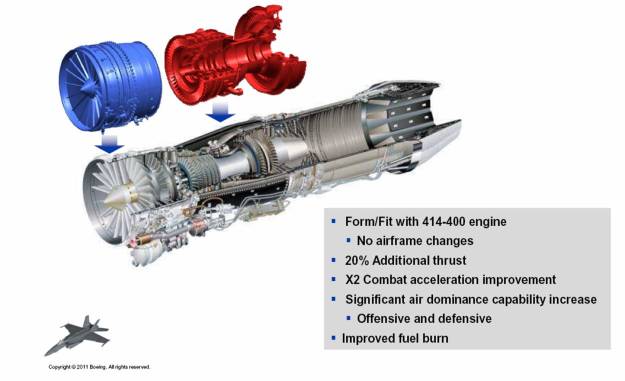
APG-79 multi-mode radar
| General data: | |
|---|---|
| Type: Radar | Altitude Max: 0 m |
| Range Max: 222.2 km | Altitude Min: 0 m |
| Range Min: 0.2 km | Generation: Late 2000s |
| Properties: Identification Friend or Foe (IFF) [Side Info], Non-Coperative Target Recognition (NCTR) – Narrow Beam Interleaved Search and Track [Class Info], Continous Tracking Capability [Phased Array Radar], Track While Scan (TWS), Low Probability of Intercept (LPI), Pulse Doppler Radar (Full LDSD Capability), Active Electronically Scanned Array (AESA) |
| Sensors / EW: |
|---|
| AN/APG-79 AESA – (F/A-18E/F, LPI) Radar Role: Radar, FCR, Air-to-Air & Air-to-Surface, Medium-Range Max Range: 222.2 km |
Source cmano-db.com
The advanced tactical radar, the APG-79 Active Electronically Scanned Array (AESA) radar provides air-to-air and air-to-ground capability with detection, targeting, tracking and protection modes. The radar is supplied by Raytheon Space and Airborne Systems at El Segundo, California.
The interleaved radar modes include real beam-mapping mode and synthetic aperture radar mode with air-to-air search, air-to-air tracking, sea surface search and ground moving target indication and tracking. The radar has an advanced four-channel receiver-exciter which provides wide bandwidth capability and the ability to generate a wide range of waveforms for electronic warfare, air-to-air and air-to-ground operation. It also has the ability to operate in multiple air-to-air and air-to-ground modes simultaneously.
AN/ALQ-218(V)2
ESM
Type: ESM
Altitude Max: 0 m
Range Max: 926 km
Altitude Min: 0 m
Range Max: 926 km
Range Min: 0 km
Generation: Early 2000s
Source cmano-db.com
The AN/ALQ-218(V)2, developed by Northrop Grumman Electronic Systems, is a variant of the Improved Capabilities (ICAP) III system deployed on the US Navy’s EA-6B Prowler aircraft. The system’s antennas are located on the port and starboard sides of the nose, the engine bays, in the wingtip pods and to the aft of the cockpit, providing 360° azimuthal cover. The passive countermeasures system provides threat detection, identification and location.
ALE-47 countermeasures dispenser

AN/ALE-47 dispenser and associated equipment

ALE-47 countermeasures dispenser under F-18E – Image: michael_block
The ALE-47 countermeasures dispenser supplied by BAE Systems Electronics and Integrated Systems in Austin, Texas, can be used with US and NATO radar and infrared decoys.
Growler weapons

The aircraft is armed with the AIM-120 AMRAAM advanced medium-range air-to-air missiles and AGM-88 HARM high-speed anti-radiation missiles.
AIM-120 AMRAAM
Advanced Anti-Radiation Guided Missile (AARGM)
The Advanced Anti-Radiation Guided Missile (AGM-88E) provides the U.S. Navy, U.S. Marine Corps and Italian Air Force the latest and most advanced weapon system for engaging and destroying enemy air defenses and time-critical, mobile targets. AARGM is a supersonic, medium-range, air-launched tactical missile compatible with U.S. and allied strike aircraft, including all variants of the F/A-18, Tornado, EA-18G, F-16, EA-6B, and F-35 (external).
Designed to upgrade the AGM-88 High-Speed, Anti-Radiation Missile system (HARM), AARGM features an advanced, digital, anti-radiation homing sensor, millimeter wave (MMW) radar terminal seeker, precise Global Positioning System/Inertial Navigation System (GPS/INS) guidance, net-centric connectivity, and Weapon Impact Assessment transmit (WIA). Missile Impact Transmitter capability is available for approved customers. The missile offers extended-range engagement, as well as organic, in-cockpit emitter targeting capability and situational awareness.
New capabilities for the warfighter include:
- Anti-radar strike with advanced signal processing and vastly improved frequency coverage, detection range and field of view
- Time-critical, standoff strike with supersonic GPS/INS point-to-point or point-to-MMW-terminal guidance
- Missile-impact zone control to prevent collateral damage through tightly coupled, Digital Terrain Elevation Database-aided GPS/INS
- Counter-emitter shutdown through active MMW-radar terminal guidance
- WIA transmission prior-to-impact for bomb damage assessment
Orbital ATK is teamed with MBDA to provide this advanced, cost-effective weapon system to U.S. and approved allied customers.
In a surveillance-only configuration the Growler is armed with two AIM-120 air-to-air missiles for self defence. For stand-off jamming and escort jamming missions the Growler is armed with two AGM-88 anti-radiation missiles plus two AIM-120 missiles.
In a strike configuration the Growler is armed with two each of AGM-88 HARM missiles, AGM-154 JSOW joint stand-off weapon (block 2 aircraft) and AIM-120 air-to-air missiles. While carrying out active transmitting jamming, the block 2 aircraft has the capability of handing off target data to other airborne, land or surface attack platforms.
EA-18G design

The EA-18G Growler aircraft is a derivative of the F/A-18F Super Hornet with structural changes and the installation of avionics and mission systems, increasing the empty weight by 800kg to 15,000kg and increasing the carrier landing weight by 1,350kg to 21,775kg.
One of the external visual characteristics is the wingtip air-to-air missiles on the F/A-18 Super Hornet are normally replaced by wideband receiver pods on the EA-18 Growler and the other hardpoints carry a mix of electronic warfare pods and weapons.


The aircraft construction includes a light alloy multispar wing and high-strength graphite and epoxy panels and doors. The major contractor Northrop Grumman manufactures the rear and centre fuselage sections and EADS CASA is responsible for the manufacture of structural components such as the fuselage rear side panels, horizontal tail surfaces, flaps, the leading edge extensions, the rudders and the speed brakes.

The aircraft has retractable tricycle-type landing gear. The Menasco main landing gear is single wheeled and turns through 90° to retract rearward into the wheel bays mounted in the engine air ducts. The aircraft has a Messier-Dowty twin-wheel nose gear. The nose of the aircraft is fitted with a catapult launch tow bar. An arrester hook is installed under the rear section of the fuselage.
Turbofan engine
The Growler is powered by two F414-GE-400 afterburning turbofan engines, supplied by General Electric. A titanium engine firewall is incorporated into the aircraft structure. The engines are rated to supply 62kN or 98kN with afterburn.
The aircraft’s power is provided by two F414-GE-400 turbofan engines from General Electric. The engines are an advanced derivative of the GE F404 engines installed on the Hornet. The air inlets have been enlarged to provide increased airflow into the engines.
The engines each provide 22,000lb thrust, with afterburn giving a maximum speed in excess of Mach 1.8.
The structural changes to the airframe on the F/E variant of the aircraft increase the internal fuel capacity by 3,600lb, a 33% higher fuel capacity than the F-18C/D variant. This extends the mission radius by up to 40%.
F414-GE-400 turbofan engines
The General Electric F414-GE-400 is a 22,000-pound class afterburning turbofan engine. The engine features an axial compressor with 3 fan stages and 7 high-pressure compressor stages, and 1 high-pressure and 1 low-pressure turbine stage. At a weight of 2,445 pounds, the F414-GE-400 has a thrust-to-weight ratio of 9. The F414 is one of the U.S. Navy’s newest and most advanced aircraft engines. It incorporates advanced technology with the proven design base of its F404 predecessor – for example the F414 features a FADEC (Full Authority Digital Engine Control) system – to provide the Boeing F/A-18E/F Super Hornet and the EA-18G Growler with a durable, reliable and easy-to-maintain engine.
Manufacturer: General Electric Co.
Thrust: 22,000 pounds
Overall Pressure Ratio at Maximum Power: 30
Thrust-to-Weight Ratio: 9
Compressor: Two-spool, axial flow, three-stage fan
LP-HP Compressor Stages: 0-7
HP-LP Turbine Stages: 1-1
Combustor Type: Annular
Engine Control: FADEC
Length: 154 in (3.91 m)
Diameter: 35 in (88.9 cm)
Dry Weight: 2,445 lbs (1,109 kg)
Platforms: F/A-18E/F Super Hornet; EA-18G Growler
Source fi-powerweb.com
US Navy studying major upgrade of F/A-18E/F & EA-18G engines
Operators: Here
Specifications (EA-18G Growler)

Data from Boeing brochure and U.S. Navy F/A-18E/F fact file.
General characteristics
- Crew: Two
- Length: 60 ft 1.25 in (18.31 m)
- Wingspan: 44 ft 8.5 in (13.62 m) (including wingtip-mounted pods)
- Height: 16 ft (4.88 m)
- Wing area: 500 ft2 (46.5 m2)
- Empty weight: 33,094 lb (15,011 kg)
- Loaded weight: 48,000 lb (21,772 kg) ; recovery weight
- Max. takeoff weight: 66,000 lb (29,964 kg)
- Powerplant: 2 × General Electric F414-GE-400 turbofans
- Dry thrust: 14,000 lbf (62.3 kN) each
- Thrust with afterburner: 22,000 lbf (97.9 kN) each
- Internal fuel capacity: 13,940 lb (6,323 kg)
- External fuel capacity: (3 x 480 gal tanks): 9,774 lb (4,420 kg)
Performance
- Maximum speed: Mach 1.8 (1,190 mph, 1,900 km/h) at 40,000 ft (12,190 m)
- Range: 1,275 nmi (2,346 km) ; clean plus two AIM-9s
- Combat radius: 390 nmi (449 mi, 722 km) ; for interdiction mission
- Ferry range: 1,800 nmi (2,070 mi, 3,330 km) ; range without ordnance
- Service ceiling: >50,000 ft (15,000 m)
- Wing loading: 92.8 lb/ft2 (453 kg/m2)
- Thrust/weight: 0.93
Armament
- Guns: None
- Hardpoints: 9 total: 6× under-wing, and 3× under-fuselage with a capacity of 17,750 lb (8,050 kg) external fuel and ordnance
- Notes: The two wingtips missile launcher rail for AIM-9 Sidewinder, found on the E/F Super Hornet, have been replaced with AN/ALQ-218 detection pods, six removable under wing mounted hard points (inboard pylons will carry 480 gal fuel tanks, mid-board pylons will carry AN/ALQ-99 High Band Jamming Pods, and outboard pylon reserved for AGM-88 HARM missiles), two multi-mode conformal fuselage stations (AIM-120 AMRAAM missiles), 1 centerline fuselage removable hardpoint, for AN/ALQ-99 Low Band Jamming Pod.
- Weapons employment: Currently, Phase I of the Growler will carry the AIM-120 AMRAAM missiles for self-protection at the two conformal fuselage stations and AGM-88 HARM missiles. The A/A-49A-2 gun system with the 20 mm M61A2 cannon has been removed and replaced by a pod of electronic boxes that control the AN/ALQ-218 and assist with the coordination AN/ALQ-99 jamming attacks.
- According to the possible weapon configurations which were revealed, EA-18G would also be capable of performing “time-sensitive” strike missions, carrying AGM-154 JSOW under wings, or multi-sensor reconnaissance missions with SHARP and AN/ASQ-228 ATFLIR on centerline and left conformal weapon stations, respectively.
Avionics
- Raytheon AN/APG-79 Active electronically scanned array (AESA) radar
- Mnemonics, Inc 990-1119-001 Electronic Attack Unit (EAU) AES Mission Computer
Source: wikipedia.org/naval-technology.com/from the net
Updated Aug 12, 2017





















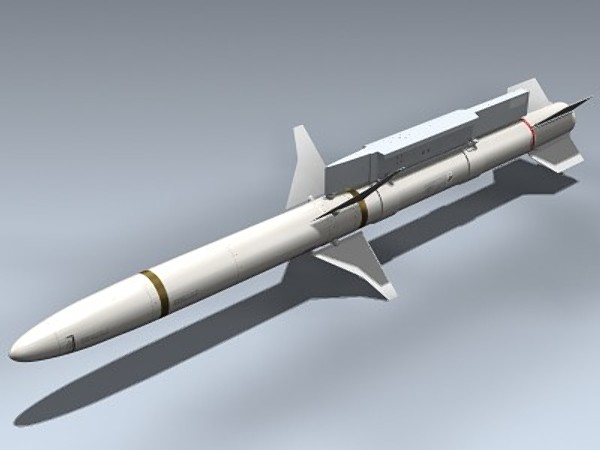

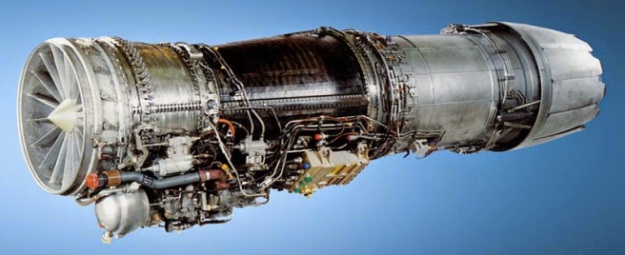
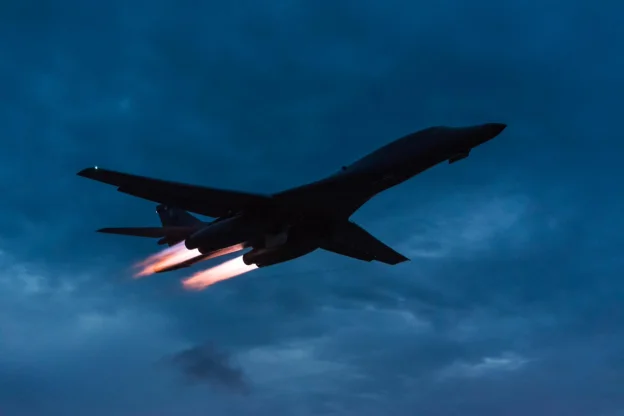


 B1 Electronic System Bay
B1 Electronic System Bay
 A U.S. Air Force B-1B Lancer takes off Oct. 2, 2014, at Dyess Air Force Base, Texas. The B-1B is undergoing the largest modification package in the aircraft’s history. Eight initial cadre from 7th Bomb Wing operational flying squadrons will spend the next three months learning the new systems. Upon the When the 9th BS returns from its current deployment, 7th BW cadre will train those pilots and weapons system officers. (U.S. Air Force photo by Senior Airman Peter Thompson/Released)
A U.S. Air Force B-1B Lancer takes off Oct. 2, 2014, at Dyess Air Force Base, Texas. The B-1B is undergoing the largest modification package in the aircraft’s history. Eight initial cadre from 7th Bomb Wing operational flying squadrons will spend the next three months learning the new systems. Upon the When the 9th BS returns from its current deployment, 7th BW cadre will train those pilots and weapons system officers. (U.S. Air Force photo by Senior Airman Peter Thompson/Released) U.S. Air Force Maj. James Silva, left, and Lt. Col. Steven Myers, both B-1B Lancer pilots, complete a flight in the first newly upgraded operational B1-B Lancer Jan. 21, 2014, at Dyess Air Force Base, Texas. The B-1B Lancer was recently upgraded with an Integrated Battle Station. The IBS is a combination of three different upgrades, which includes a Fully Integrated Data Link, a Vertical Situation Display upgrade, and a Central Integrated System upgrade. The VSDU upgrades the B-1’s forward cockpit by replacing two unsupportable, monochrome pilot and co-pilot displays with four multifunctional color displays, giving pilots more situational awareness data in a user-friendly format. (U.S. Air Force photo by Staff Sgt. Richard Ebensberger/Released)
U.S. Air Force Maj. James Silva, left, and Lt. Col. Steven Myers, both B-1B Lancer pilots, complete a flight in the first newly upgraded operational B1-B Lancer Jan. 21, 2014, at Dyess Air Force Base, Texas. The B-1B Lancer was recently upgraded with an Integrated Battle Station. The IBS is a combination of three different upgrades, which includes a Fully Integrated Data Link, a Vertical Situation Display upgrade, and a Central Integrated System upgrade. The VSDU upgrades the B-1’s forward cockpit by replacing two unsupportable, monochrome pilot and co-pilot displays with four multifunctional color displays, giving pilots more situational awareness data in a user-friendly format. (U.S. Air Force photo by Staff Sgt. Richard Ebensberger/Released)






 AGM-86B-C air launch cruise missile (ALCM)
AGM-86B-C air launch cruise missile (ALCM)
 Image: fas.org
Image: fas.org GBU-54 Laser Joint Direct Attack Munitions
GBU-54 Laser Joint Direct Attack Munitions

 CBU-87, -89, -97 cluster munitions
CBU-87, -89, -97 cluster munitions CBU-103, -104, -105 wind-corrected munitions dispensor (WCMD)
CBU-103, -104, -105 wind-corrected munitions dispensor (WCMD) Boeing JDAM 1,000lb mk83, 1,000lb BLU-110, 2,000lb mk84 and 2,000lb BLU-109
Boeing JDAM 1,000lb mk83, 1,000lb BLU-110, 2,000lb mk84 and 2,000lb BLU-109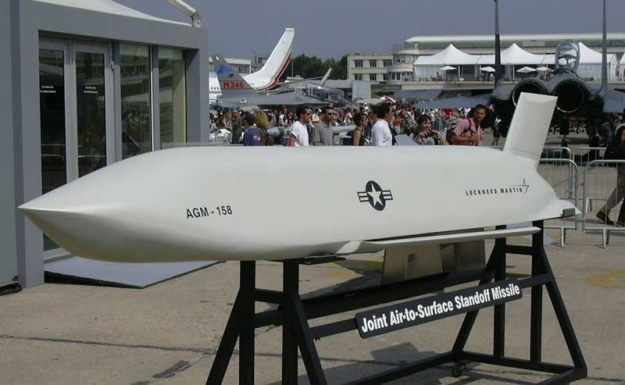




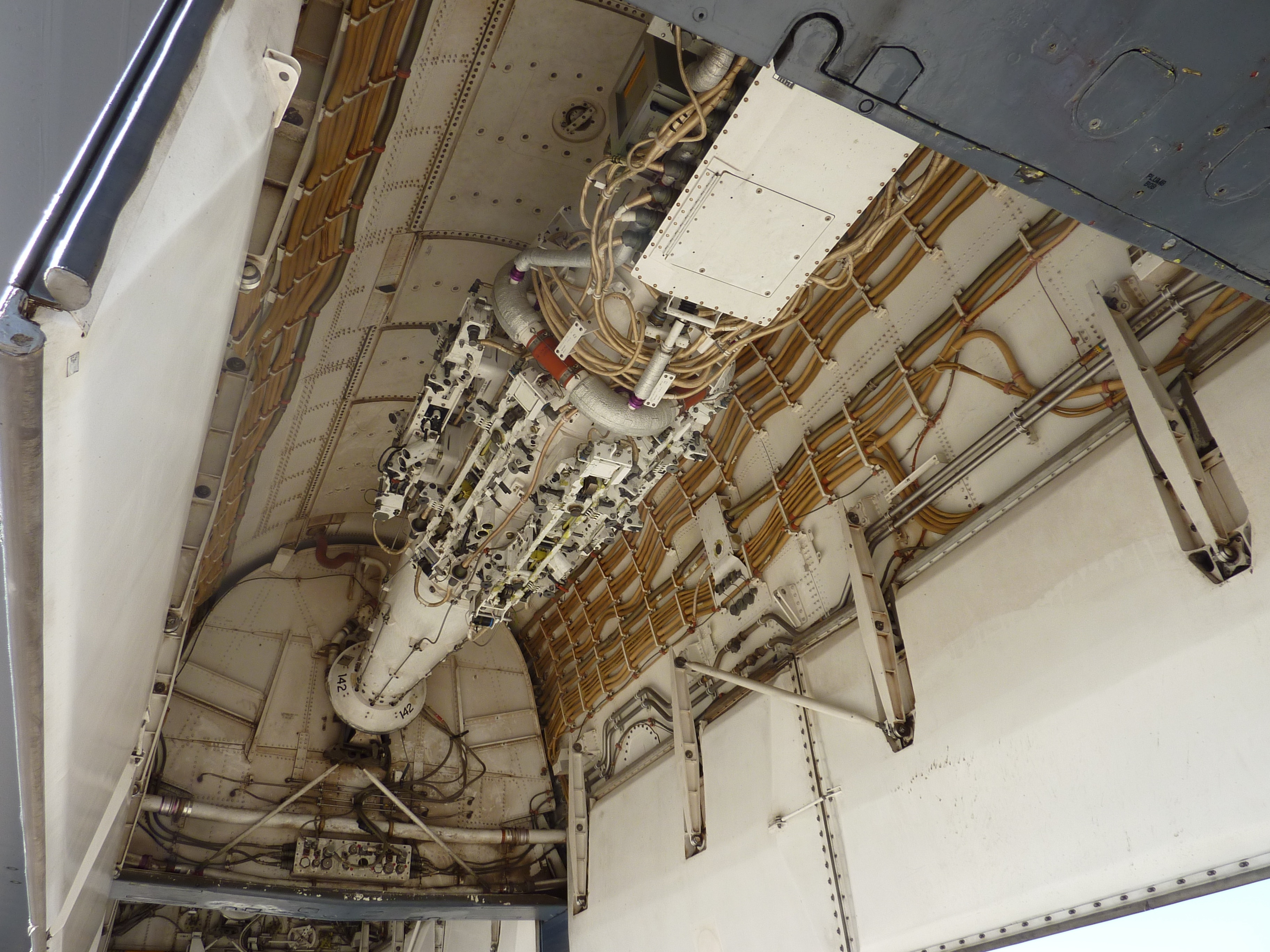




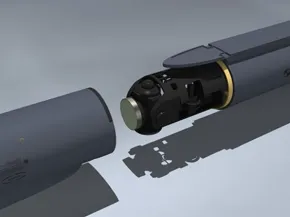







 Image: defense-update.com
Image: defense-update.com





